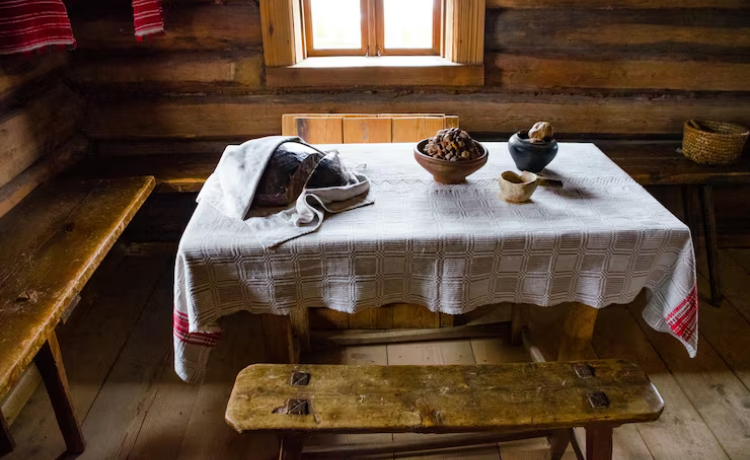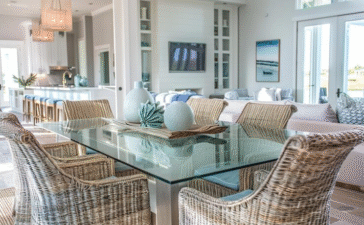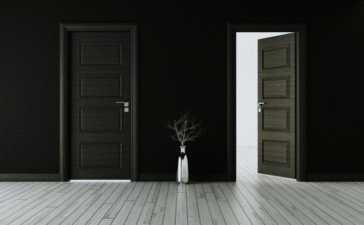Farmhouse tables have become a staple in home decor, celebrated for their ability to blend rustic charm with modern elegance. Their appeal lies in their versatility, seamlessly fitting into various interior styles while creating a warm, inviting atmosphere. Whether you’re drawn to a traditional country look or a sleek, contemporary design, a farmhouse table can serve as the perfect centerpiece for your dining space.
This guide offers a deep dive into the world of farmhouse tables. We’ll explore everything from distinct design styles and materials to sizing, budget-friendly options, and maintenance tips. Understanding these elements will help you select or create a table that not only elevates your dining experience but also becomes a cherished part of your home for years to come.
What Is a Farmhouse Table?
A farmhouse table is defined by its sturdy construction and simple, functional design, echoing the furniture traditionally found in rural farmhouses. These tables were built to be the heart of the home—a place for family meals, daily tasks, and community gatherings.
Key features often include robust, thick legs, a solid wood top, and a rustic finish that showcases the natural grain and imperfections of the material. While designs have evolved, the core principles of durability, simplicity, and a welcoming aesthetic remain central to the farmhouse style.
Farmhouse Table Design Styles
The farmhouse table has been reinterpreted in many ways, leading to a variety of styles that can suit almost any home. Understanding these different designs can help you find the perfect match for your decor.
Rustic Farmhouse Tables
The rustic farmhouse table is the most traditional interpretation. It emphasizes natural wood, often with a distressed or weathered finish that tells a story. These tables feature prominent wood grain, knots, and a handcrafted feel that brings a sense of history and warmth to a room. A classic rustic farmhouse table is perfect for creating a cozy, lived-in atmosphere.
Modern Farmhouse Tables
A modern farmhouse dining table offers a cleaner, more refined take on the classic design. It often features sleeker lines, smoother finishes, and a more minimalist silhouette. These tables might pair a solid wood top with metal legs or use a lighter wood stain for a more contemporary feel. This style, popularized by designers like Joanna Gaines, strikes a balance between rustic comfort and modern sophistication.
French Country Farmhouse
Inspired by the pastoral elegance of rural France, the French country style adds a touch of refinement to the rustic farmhouse look. These tables often have carved, ornate legs, scalloped edges, and a softer, more delicate finish. They might be painted in light, creamy colors and lightly distressed to achieve an antique look.
Glam Farmhouse
For those who love a bit of sparkle, the glam farmhouse style combines rustic elements with chic, luxurious touches. This style might incorporate a solid wood top with polished metal legs, a high-gloss finish, or other glimmering accents. It’s a bold fusion that proves farmhouse style furniture can be both down-to-earth and glamorous.
Transitional Farmhouse
Transitional farmhouse tables bridge the gap between classic and contemporary design. They blend the sturdy, traditional form of a farmhouse table with updated features like cleaner lines or mixed materials. This style is incredibly versatile, fitting well into homes that mix different decor elements.
Materials and Construction
The material of a farmhouse table is crucial to its look, feel, and longevity. Wood is the primary material, with different types offering unique benefits.
Solid Hardwood
Hardwoods like oak, maple, and walnut are popular choices for their exceptional durability and timeless appeal. A solid wood farmhouse table made from hardwood is resistant to dents and scratches, making it a long-lasting investment. Reclaimed wood is another excellent option, offering a unique history and character. Reclaimed wood tables are not only sustainable but also feature distinct markings that make each piece one-of-a-kind.
Softwood Options
Softwoods such as pine and spruce are also commonly used for farmhouse tables, particularly for more rustic or budget-friendly designs. A pine farmhouse table is lighter and more affordable than hardwood options. While it may be more susceptible to scratches, many feel this adds to its rustic charm over time, creating a beautiful patina.
Size and Seating Capacity
Choosing the right size for your farmhouse table is essential for both function and aesthetics. It needs to fit your space comfortably while accommodating your family and guests.
Table Sizes for Different Spaces
Measure your dining room or kitchen area before you start shopping. A good rule of thumb is to leave at least three feet of clearance around the table to allow for easy movement. This ensures that the table doesn’t overwhelm the room and that guests can comfortably sit down and get up. For smaller homes or apartments, there are many compact farmhouse tables for small spaces that offer the same style without taking up too much room.
Extendable Farmhouse Tables
An extendable farmhouse table is a fantastic solution for those who love to entertain. These tables come with leaves that can be added to increase the seating capacity for larger gatherings. This flexibility allows you to have a smaller table for daily use and a larger one when you have company, making it a practical choice for many households.
Seating Capacity
Consider how many people you typically host. Farmhouse table seating capacity is a key factor. A standard rectangular table that is 6 feet long can usually seat six people comfortably. A 7-foot table can accommodate eight, and an 8-foot table can seat up to ten. Always check the manufacturer’s recommendations to ensure you choose a table that meets your needs.
DIY Farmhouse Tables
For those who enjoy a hands-on project, building your own farmhouse table can be a rewarding experience. A DIY farmhouse table allows you to create a piece that is perfectly tailored to your space and style.
There are countless plans and tutorials available online that provide step-by-step instructions on how to build a farmhouse table. You can customize the size, finish, and design to create a truly unique piece. The necessary tools typically include a saw, drill, sander, and measuring tape, along with wood, screws, and your chosen finish. Building your own table not only saves money but also results in a piece of furniture with personal meaning.
Budget-Friendly Farmhouse Table Options
You don’t need to spend a fortune to bring the charm of a farmhouse table into your home. There are many affordable farmhouse tables available that deliver style without the high price tag.
Look for a budget farmhouse dining table at large retailers, online marketplaces, or second-hand stores. Buying a pre-loved table and refurbishing it can be a great way to get a high-quality piece for less. A fresh coat of paint or a new stain can completely transform an old table.
How to Care for Your Farmhouse Table
Proper care is essential to maintaining the beauty and longevity of your farmhouse table. Simple maintenance can keep your table looking its best for years.
For daily cleaning, a soft, damp cloth is usually sufficient. Avoid harsh chemicals that can damage the wood finish. Use placemats, coasters, and trivets to protect the surface from scratches, heat, and moisture. For a solid wood table, periodically applying a quality wood polish can help preserve its luster and protect the material.
Trends in Farmhouse Table Designs
Farmhouse design continues to evolve, with new trends emerging each year. Current modern farmhouse trends include mixing materials, such as pairing a wood top with a marble or brass base. Unique table shapes, like those with scalloped or live edges, are also gaining popularity. Influential designers like Joanna Gaines continue to shape the aesthetic, often promoting designs that feel both authentic and fresh, ensuring that farmhouse table designs for 2025 remain exciting and relevant.
Also Check: “Farm house Kitchen Table “
Finding Your Perfect Table
A farmhouse table is more than just a piece of furniture; it’s a gathering place that can enhance your home and create lasting memories. From rustic and traditional to modern and glam, there is a style to suit every taste. By considering the material, size, and design, you can find the perfect farmhouse table to become the heart of your home. Explore your options and get ready to bring this timeless piece into your space.
Frequently Asked Questions
What defines a table as “farmhouse style”?
A farmhouse table is typically characterized by its sturdy, simple construction, use of solid wood, and a rustic or natural finish. The design prioritizes function and durability, often featuring thick legs and a substantial tabletop, reflecting its origins as a workhorse piece of furniture in a rural home.
Are farmhouse tables still in style in 2025?
Yes, farmhouse tables remain very much in style. The design has evolved to include modern, transitional, and even glamorous interpretations, making it adaptable to a wide range of interior decors. Its timeless appeal, durability, and welcoming nature ensure its continued popularity.
What is the best wood for a farmhouse table?
Hardwoods like oak, maple, and reclaimed wood are considered the best for a farmhouse table due to their durability and resistance to wear and tear. They are a long-term investment. Softwoods like pine are more budget-friendly and can develop a charming, distressed look over time, which many people appreciate in a rustic piece.
How do I choose the right size farmhouse table?
To choose the right size, measure your dining space and leave at least 36 inches of clearance around the table for chairs and movement. Consider the number of people you typically seat. An extendable table is a great option if you need flexibility for guests.
Can I use a farmhouse table in a modern home?
Absolutely. A modern farmhouse table, which features cleaner lines and often mixes materials like wood and metal, can be a perfect fit for a modern home. Its simple, unpretentious design can add warmth and texture to a minimalist or contemporary space.












